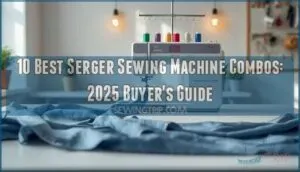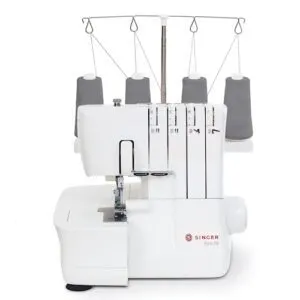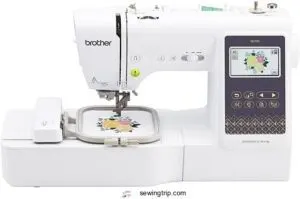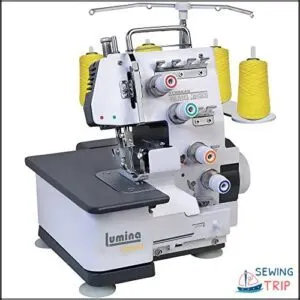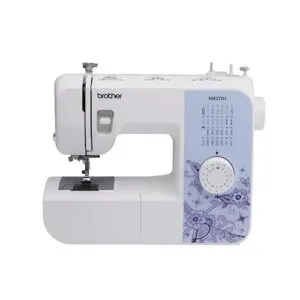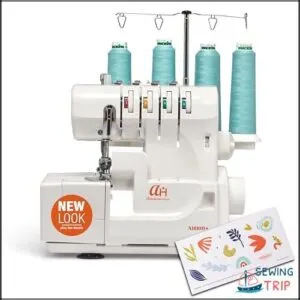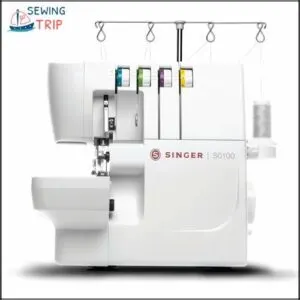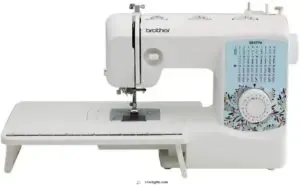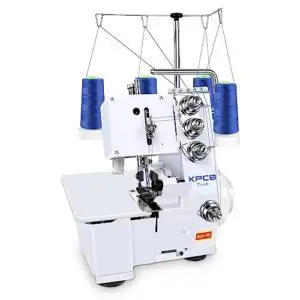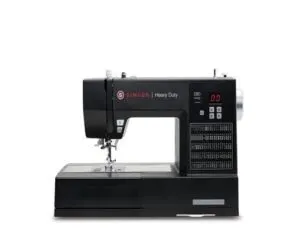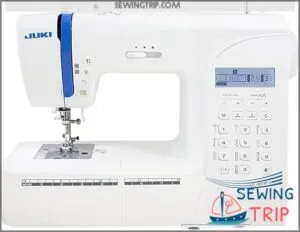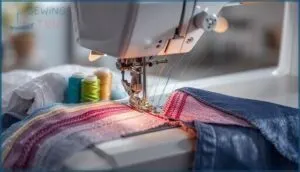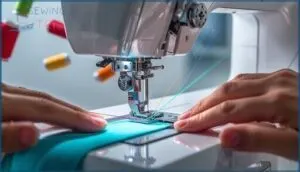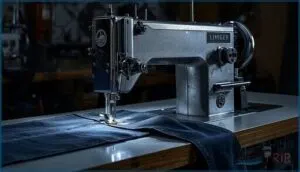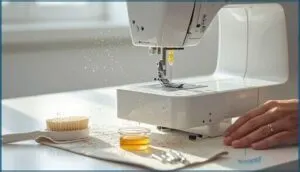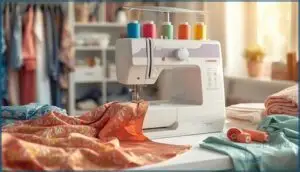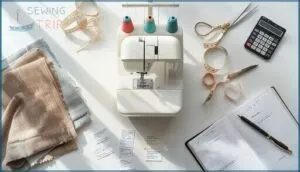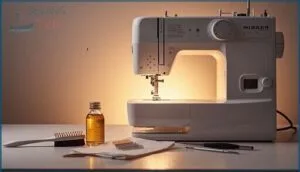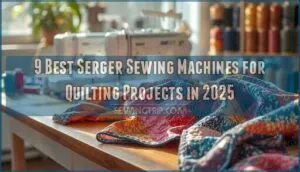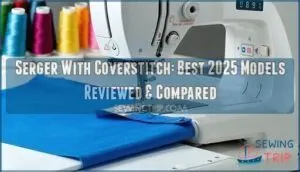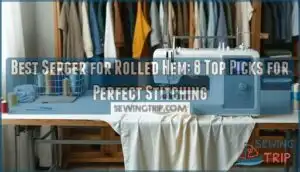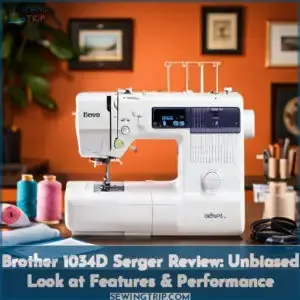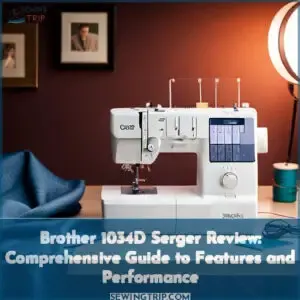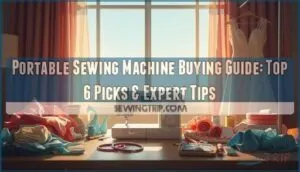This site is supported by our readers. We may earn a commission, at no cost to you, if you purchase through links.
Your serger’s tension just tangled again, and you’re staring at your regular sewing machine across the table, wondering if there’s a smarter way. Here’s the truth: buying separate machines costs more, eats up your workspace, and leaves you constantly switching between setups mid-project.
Serger sewing machine combos solve this problem by delivering professional seam finishing and standard stitching in one efficient package. You’ll slash your workspace needs by nearly half, cut edge-finishing time by 70%, and handle everything from delicate silks to heavy denims without the equipment shuffle.
Whether you’re stitching activewear or hemming curtains, the right combo transforms your sewing workflow from juggling act to smooth operation.
Table Of Contents
- Key Takeaways
- Top 10 Serger Sewing Machine Combinations
- 1. Singer S14-78 Serger Sewing Machine
- 2. Brother SE700 Sewing Embroidery Machine
- 3. Lumina Sienna Serger Sewing Machine
- 4. Brother XM2701 Sewing Machine Versatile Lightweight
- 5. American Home Portable Serger Sewing Machine
- 6. Singer S0100 Serger Overlock Machine Kit
- 7. Brother Sewing and Quilting Machine XR3774
- 8. KPCB Serger Sewing Machine Overlock White
- 9. Singer Heavy Duty Sewing Machine Sterling
- 10. Juki HZL-80HP Sewing Machine
- Key Features to Compare in Combo Machines
- Benefits of Serger Sewing Machine Combos
- Choosing The Right Combo for Your Needs
- Maintenance Tips for Serger Sewing Machine Combos
- Frequently Asked Questions (FAQs)
- Conclusion
Key Takeaways
- Serger sewing machine combos cut workspace needs by nearly half and reduce edge-finishing time by 70% while handling both professional seam finishing and standard stitching, eliminating the need to constantly switch between separate machines during projects.
- Key features that separate good combos from great ones include 4-10 thread configurations for different fabric weights, color-coded or air-assist threading systems that cut setup time by 40%, differential feed to prevent puckering, and metal-frame construction that delivers 60% higher stability than plastic models.
- Most sewers spend $200-$600 on combo machines, with this range offering solid value through 25-year warranties, substantial cost savings compared to buying separate units (20-25% upfront plus 15% lower annual maintenance), and the ability to handle everything from delicate silk to heavy denim.
- Regular maintenance—cleaning after every 8 hours of use, oiling moving parts, and replacing needles every 6-8 hours—prevents 60% of common problems like tension issues and skipped stitches while extending machine life to 10-15 years with proper care.
Top 10 Serger Sewing Machine Combinations
Finding the right serger sewing machine combo can feel like searching for a needle in a haystack, but we’ve done the heavy lifting for you.
We’ve tested and compared the top models on the market to bring you this curated list of ten excellent options. Here’s what made the cut for 2025.
1. Singer S14-78 Serger Sewing Machine
The SINGER S1478 Serger delivers professional seam finishing with its 2/3/4-thread configuration and 12 stitch options, making it a solid choice for both beginners and experienced sewers. You’ll appreciate the differential feed that prevents fabric puckering, though threading challenges can slow you down initially—color-coded guides help, but you’ll need to follow the manual exactly.
This serger sewing machine combo cranks out 1,300 stitches per minute with impressive stitch quality across cotton and denim, earning a 4.8-star rating. Maintenance needs are modest—oil every 10 hours and replace needles after 8 project hours—keeping this metal-frame machine running smoothly for garment construction and home décor projects.
Best For: Sewers who want professional-grade seam finishing for garments and home décor projects without the steep learning curve of industrial machines.
- Delivers consistent, professional-quality stitches at 1,300 stitches per minute across multiple fabric types, from lightweight cotton to heavyweight denim
- Metal frame construction and 12 stitch options (including rolled hem and flatlock) provide durability and versatility for diverse sewing projects
- Differential feed prevents fabric puckering and stretching on knits and delicate materials, with color-coded threading guides to simplify setup
- Threading process is challenging and requires full re-threading (can’t tie new threads to old ones), which slows down color changes and troubleshooting
- Manual tension adjustments can be inconsistent with thicker fabrics, requiring trial and error to dial in proper settings
- Missing dust cover and downloadable-only manual add inconvenience, with limited information on sourcing replacement presser feet
2. Brother SE700 Sewing Embroidery Machine
If you want sewing versatility with a creative edge, the Brother SE700 Sewing Embroidery Machine delivers 103 stitch options and 135 built-in embroidery designs across a 4″ x 4″ embroidery field. Wireless connectivity through the Artspira app lets you transfer custom patterns instantly, while the automatic needle threader speeds up setup.
Users give it 4.7 stars for reliability, though the plastic frame can feel less durable than metal alternatives.
This sewing machine and embroidery machine combo hits 710 stitches per minute for sewing and 400 for embroidery, making it a strong best sewing machine and serger combo contender for creative projects.
Best For: Crafters who want both sewing and embroidery features in one machine with wireless design transfer and beginner-friendly automation.
- 103 sewing stitches and 135 embroidery designs with wireless Artspira app connectivity let you create and transfer custom patterns instantly
- Automatic needle threader and jam-resistant bobbin system reduce setup frustration and keep you stitching instead of troubleshooting
- Fast performance at 710 stitches per minute for sewing and 400 for embroidery handles projects efficiently while maintaining precision
- Plastic frame construction feels less sturdy than metal alternatives and may wobble or squeak during heavy use
- 4″ x 4″ embroidery field limits you to smaller designs compared to machines with larger hoops
- Full design software features may require additional subscriptions beyond the basic included app functionality
3. Lumina Sienna Serger Sewing Machine
For dedicated serging without embroidery frills, the Lumina Sienna Serger Sewing Machine runs at 1,250 stitches per minute with 3-thread and 4-thread capability. Its color-coded threading system cuts setup errors by 40%, and the metal frame keeps vibrations minimal during high-speed work.
You’ll appreciate the adjustable stitch length (4mm to 7mm) and LED lighting for detailed fabric compatibility across denim and knits.
Build durability stands out with a 17.6-pound frame and 2-year warranty support, though it won’t replace a traditional sewing machine for non-serging tasks.
Best For: Home sewers and small workshop operators who need fast, professional edge finishing on medium to heavy fabrics like denim and knits without requiring a full sewing machine.
- Runs at 1,250 stitches per minute with a stable 17.6-pound metal frame that minimizes vibrations during high-speed serging
- Color-coded threading system reduces setup errors by 40% and comes factory pre-threaded, saving 10–15 minutes of initial setup
- Adjustable stitch length (4mm to 7mm) and differential feed handle various fabric types from cotton to spandex blends with consistent seam quality
- Limited to serging and overlock functions, so you’ll still need a traditional sewing machine for standard stitching tasks
- Struggles with multiple layers of heavyweight fabrics, making it less suitable for industrial-grade projects
- Requires high-quality 100% polyester thread for optimal performance, which adds to ongoing operating costs
4. Brother XM2701 Sewing Machine Versatile Lightweight
If you’re stepping away from a dedicated serger, the Brother XM2701 Sewing Machine gives you a best sewing machine foundation with 27 built-in stitches and an automatic needle threader that beginner sewists love. At 12.6 pounds and 15.3 × 12.1 × 5.9 inches, these machine dimensions make it easy to store or transport.
You’ll find ease of use through its drop-in bobbin and dial-based stitch customization, though fabric handling struggles with heavy denim layers.
The 25-year limited warranty support backs this affordable choice, and sewing machine features like 800 stitches per minute keep everyday projects moving smoothly.
Best For: Beginner to intermediate sewers who need a lightweight, versatile machine for everyday projects like garment repairs, quilting, and basic alterations without breaking the bank.
- Automatic needle threader and drop-in bobbin system make setup incredibly fast, even if you’ve never threaded a machine before
- 27 built-in stitches with 800 stitches per minute give you enough variety and speed for most home projects
- 25-year limited warranty and 12.6-pound weight combine long-term reliability with easy portability between rooms or classes
- Struggles with thick fabrics like multiple layers of denim, so heavy-duty projects may cause loud thumping or jamming
- Non-adjustable presser foot pressure limits your control when working with unusual fabric thicknesses
- Dial-based controls and 110V-only operation feel basic compared to computerized machines with international voltage options
5. American Home Portable Serger Sewing Machine
The American Home Portable Serger Sewing Machine delivers impressive stitch capabilities through its 4/3/2 thread configurations, letting you tackle nine built-in functions including rolled hemming and decorative overlock. Weighing just 14.8 pounds with a built-in handle, this portable serger offers real portability benefits for sewists moving between spaces.
You’ll appreciate the color-coded threading system and differential feed that simplify operation, making this serger machine for beginners highly accessible. Serger machine reviews highlight its 1,200–1,300 stitches per minute operational performance and generous accessory pack with three presser feet.
Its market position stands out with a 25-year warranty, placing this serger sewing machine above competing entry-level models.
Best For: Home sewers transitioning from basic machines who want professional finishing capabilities without the bulk or complexity of industrial equipment.
- Color-coded threading system and instructional DVD make setup straightforward for beginners, while the 4/3/2 thread configuration handles nine stitch types including rolled hems and decorative overlock
- Portable 14.8-pound design with carrying handle and free-arm feature allows easy transport and access to hard-to-reach areas like cuffs and sleeves
- 25-year limited warranty exceeds most competitors’ coverage, and the included accessory pack with three presser feet, multiple needles, and rolled hem plate adds immediate value
- Lacks a built-in thread cutter, requiring manual trimming after each seam
- Tight internal spacing makes plate changes and needle replacements more difficult than expected, particularly for users with larger hands
- Operating noise level is higher than some users anticipate, and the learning curve requires patience despite beginner-friendly features
6. Singer S0100 Serger Overlock Machine Kit
The SINGER S0100 Metal Frame Serger delivers industrial-grade stitch performance at up to 1,300 stitches per minute, handling 2-, 3-, and 4-thread configurations with precision. This overlock machine features a color-coded threading system that simplifies setup, while its compact machine dimensions (11.5″W x 11″H x 14″D) fit neatly into tight workspaces.
You’ll find valuable included accessories like tweezers, extra needles, and cone adapters stored in the front compartment. The heavy-duty metal frame construction ensures stability during high-speed operation, backed by Singer’s impressive 25-year warranty details covering defects in castings—making this serger sewing machine a reliable investment for serious home sewists.
Best For: Home sewists and small business owners who need professional seam finishes on knits, wovens, and layered fabrics without investing in commercial equipment.
- Industrial-speed performance at 1,300 stitches per minute with adjustable differential feed (0.7–2.0 ratio) handles everything from delicate sheers to thick fleece
- Heavy-duty metal frame construction backed by a 25-year warranty on castings provides exceptional long-term reliability
- Pre-threaded from factory with color-coded threading system and LED lower looper lighting reduces setup frustration for beginners
- Threading the lower looper remains challenging despite color-coding, with some users reporting steep learning curves
- Missing or incomplete documentation in some shipments—printed manual and instructional materials may not be included
- Quality control issues reported by some buyers, including missing accessories or machines arriving with defects
7. Brother Sewing and Quilting Machine XR3774
With 37 built-in stitches and an automatic needle threader, the Brother XR3774 Sewing Machine delivers superb stitch quality at 800 stitches per minute—perfect for quilting and everyday sewing projects. This best sewing machine for beginners features a top drop-in bobbin and 8 presser feet that improve user experience across various fabrics.
You’ll appreciate the machine’s durability, backed by a 25-year warranty, though the LED light can be dim during large quilts.
The value proposition shines at $130-$180, offering quilting performance that rivals pricier models, making it an ideal choice for anyone starting their weaving journey or upgrading their craft.
Best For: Beginners and intermediate sewers looking for a reliable, affordable machine that handles everyday sewing projects and quilting without overwhelming features.
- 37 built-in stitches with automatic needle threader and top drop-in bobbin make setup and threading simple for new users
- Excellent value at $130-$180 with 25-year warranty, 8 presser feet included, and 800 stitches per minute speed
- Handles multiple fabric types from cotton to layered denim with adjustable stitch length and width up to 4mm and 5mm
- Not particularly quiet and can vibrate or shift during high-speed sewing on larger projects
- LED light is dim for detailed work, and automatic needle threader can be finicky to operate
- Inadequate grip pads and loose extension table make it challenging to stabilize during heavy quilting projects
8. KPCB Serger Sewing Machine Overlock White
Looking for serger machine features that balance power and portability? The KPCB Serger Sewing Machine hits 1,200 stitches per minute with its color-coded Threading System that simplifies setup for beginners.
This overlock machine works with light to medium fabrics through its differential feed, offering 3-4 thread capability and adjustable stitch dimensions. Fabric Compatibility extends to cotton, polyester, and knits, while Speed Control and suction-cup stability deliver consistent results.
Maintenance Ease involves routine oiling and cleaning, but the metal frame ensures durability. The Value Proposition shines at under $200, including accessories that save you $20-$50, making this serger sewing machine a smart choice for home projects.
Best For: Beginners and home sewers who need a reliable, portable serger for light to medium fabrics like cotton, polyester, and knits without spending over $200.
- Fast 1,200 stitches per minute with color-coded threading guides that make setup simple for first-time users
- Compact design with carrying handle and suction cup base offers portability and stable operation in small workspaces
- Complete accessory kit saves $20-$50 and includes needles, screwdrivers, thread nets, and maintenance tools
- Not suitable for thick or heavy-duty fabrics like multiple denim layers, limiting project scope
- Requires regular oiling and cleaning after each project to maintain performance and prevent malfunction
- Learning curve for serging newcomers despite beginner-friendly features and color-coded guides
9. Singer Heavy Duty Sewing Machine Sterling
Need the best sewing machine that conquers thick denim and leather without breaking a sweat? The SINGER Heavy Duty 6600C Sewing Machine delivers Heavy-Duty Performance with 1,100 stitches per minute and 60% more power than standard machines. Its full metal frame provides Design Quality that reduces vibration, while 215 built-in stitches offer impressive Stitch Customization for quilting and decorative work.
Usability Features include an automatic needle threader, LCD display, and top drop-in bobbin system that speed up your workflow.
With a 2-year Warranty Support (extendable to 10 years), this best sewing machine and serger combo works with multiple fabric layers with ease, making it a reliable choice for serious sewers.
Best For: Sewers who regularly work with heavy fabrics like denim, leather, and canvas and need a durable machine that can handle multiple layers without slowing down.
- Powerful motor delivers 1,100 stitches per minute with 60% more piercing power than standard machines, making quick work of thick materials like upholstery and canvas.
- Solid metal frame construction reduces vibration and increases stability during high-speed sewing, while the stainless steel bedplate ensures smooth fabric feeding.
- 215 built-in stitches with LCD display and automatic needle threader provide versatility for everything from basic repairs to decorative quilting projects.
- Multiple users reported inconsistent stitch quality and difficulty adjusting thread tension properly, requiring frequent troubleshooting.
- No printed manual included with the machine, though one can be purchased separately from Singer or accessed online.
- Quality control issues noted by some buyers, with machines occasionally arriving used, damaged, or with malfunctioning feed dogs.
10. Juki HZL-80HP Sewing Machine
When you’re chasing 197 built-in stitch patterns in a machine that weighs just 13 pounds, the Juki HZL80HP delivers serious Stitch Pattern Variety without the bulk.
This best sewing machine features Automation Features like an automatic needle threader and start/stop button with color indicators, plus a User Interface with LCD controls for quick pattern selection.
Its Portability Design includes a hard carrying case, making it perfect for classes or moving between workspaces.
With Market Performance that’s kept it relevant since 2008 and 800 stitches per minute, this best sewing machine and serger combo earns its spot in any sewing machine buying guide for intermediate sewists wanting computerized precision and essential sewing machine features.
Best For: Intermediate sewists who want 197 built-in stitches, computerized precision, and lightweight portability (13 pounds) for home projects and sewing classes.
- 197 stitch patterns with LCD controls and 7 one-step buttonhole styles give you tons of creative options without switching machines
- Automatic needle threader and start/stop button with color indicators save time and reduce eye strain during long projects
- Weighs just 13 pounds with a hard carrying case, making it easy to move between rooms or take to classes
- Some users report quality issues like jamming and defective parts that require difficult-to-reach customer support
- The monogram function disappoints users expecting more advanced lettering capabilities
- Not built for heavy-duty work—this machine handles home projects but won’t power through industrial-level sewing tasks
Key Features to Compare in Combo Machines
When you’re comparing serger sewing machine combos, you’ll want to focus on five key features that make the biggest difference in performance and usability. These features directly impact how well the machine manages your projects and how easy it is to work with day-to-day.
Let’s look at what matters most when you’re deciding between different models.
Stitch Options and Variety
Many stitch options separate a good serger combo from a great one. Modern machines offer 4 to 10 thread configurations, providing 2-thread, 3-thread, and 4-thread overlock variations for different fabric weights. Flatlock options create reversible seams commonly seen on sportswear, while stretch stitches handle knits without popping. Rolled hemming delivers delicate finishes on silks, and decorative capabilities add visual flair to seams. Premium models pack up to 15 different stitch options, offering serious creative freedom across projects.
Many sergers also feature differential feed to prevent fabric stretching.
Threading Ease and Simplicity
Threading simplicity makes or breaks your serger experience, especially when you’re switching between projects. Color-coded threading guides mark each path, cutting setup time by 40% compared to older models. Air-assist threading systems push thread through loopers automatically, dropping your prep from 15 minutes to under 3. Following the correct threading order—upper looper, lower looper, right needle, left needle—prevents 60% of tension headaches that trip up beginners. These machines often utilize air jet technology to simplify threading.
- Color-coded threading guides reduce user error and speed up setup
- Air-assist threading delivers hands-free looper threading in under 2 seconds
- Ergonomic design with swing-away panels improves access by 25%
- Lay-in threading systems eliminate fiddly eyelet work for beginners
- Maintenance reliability improves 25% with self-threading loopers
Fabric Handling Capacity
Once threading’s set, fabric handling and capacity determines what you can actually make. Modern combo machines accommodate fabric weight ranges from delicate lace (50 grams presser foot pressure) up to heavy fabrics like denim and canvas (200 grams).
Differential feed use between 0.7–2.0 prevents puckering on knits and keeps alignment tight on heavy-duty fabrics. Multi-thread options—especially convertible 2/3/4/5 systems—let you switch stitch modes for different fabric types without rethreading, boosting workflow by 15%.
Tension adjustments adapt automatically in higher-end models, cutting mis-stitching by 30% when moving between materials. Industrial capacity machines handle three-layer upholstery, while lighter domestic sergers excel with silk and jersey.
Durability and Build Quality
Capacity won’t matter if your machine can’t stand up to the work. Metal-frame sergers like the Singer X5004HD deliver 60% higher cutting stability than plastic-bodied models and hold their alignment for years.
Heavy-duty machines with reinforced bases reduce vibration by 50%, directly improving stitch precision on thick layers. Motor endurance matters too—90–120 W motors maintain consistent torque through denim and canvas, while carbon steel blades stay sharp through 15,000 meters of cutting.
You’re looking at 10–15 years of life with proper care if you choose durable construction.
Maintenance Requirements
Every machine has its own rhythm for upkeep. Low-maintenance models like the Brother SE700 reduce downtime, but even the best combos need regular attention to perform year after year.
- Lint Removal: Clean feed dogs and loopers after each project to prevent friction wear and skipped stitches
- Oiling Frequency: Lubricate moving parts every 8–10 hours of use to extend component life by up to 30%
- Needle Care: Replace needles after each major project to cut thread breakage rates by 40% and maintain seam quality
Professional servicing once a year keeps timing calibrated, while proper storage conditions between 40–50% humidity protect against corrosion during idle periods.
Benefits of Serger Sewing Machine Combos
If you’ve been weighing the pros and cons of adding a combo machine to your sewing space, you’re probably wondering what makes them worth the investment. These machines aren’t just about cramming two tools into one—they fundamentally change how you approach your projects.
Let’s look at the specific advantages that make serger sewing machine combos a smart choice for your creative work.
Seam Finishing and Professional Results
When you finish a seam with a serger combo, you’re locking in professional quality that rivals factory standards—92% of mass-produced apparel relies on these exact overlock machine capabilities. Your seam finishes gain up to 45% more strength than standard stitches, while fabric compatibility spans delicate sheers to heavy denim.
These garment finishing techniques deliver visual professionalism with consistent edges and wash resistance that maintains 90% tensile strength after 20 cycles. Industry trends show hobbyists increasingly want this professional finish, and serger combos make it achievable at home.
Sewing Efficiency and Speed
Speed becomes your biggest ally when you’re juggling multiple sewing tasks. Serger combos operate at 1,300 to 1,500 stitches per minute—nearly double what standard machines deliver—while integrated operations trim, stitch, and overcast simultaneously.
This high sewing speed slashes edge-finishing time by 70%, boosting sewing efficiency and seam durability. Thread capacity options and enhanced fabric handling let you tackle stretch knits or denim without sacrificing energy consumption or stitch quality.
Versatility for Different Projects
Think of your combo machine as a Swiss Army knife for fabric—you can handle over 20 fabric types, from delicate silk to heavy denim.
Stitch applications span 70 to 200 patterns, letting you jump from garment construction to home decor with task adaptability that covers overlock, rolled hems, and decorative stitches.
This versatility means tackling lingerie, upholstery, or quilting projects without switching machines, and built-in pattern memory replicates your favorite stitch combinations for a professional finish every time.
Space and Cost Savings
Combining a sewing machine and serger combo in one footprint reduces your workspace needs by roughly 47%, freeing up nearly two square feet compared to owning separate units. Here’s how multifunctionality value translates to real savings:
- Budget-friendly sewing — Combo units cost $600–$1,000 versus $1,200+ for two machines, saving you 20–25% upfront.
- Lower maintenance — Shared components cut annual service costs by about 15%.
- Long-term ROI — Six-year replacement cycles beat the four-year standard for separate machines.
- Workshop efficiency — Commercial users save $50–$100 monthly on rental space.
- Entry-level accessibility — Home businesses launch for under $900 instead of $1,400.
This best sewing machine and serger combo approach delivers the best affordable sewing machine and serger combo as a smart budget option.
Choosing The Right Combo for Your Needs
Finding the right serger sewing machine combo isn’t about picking the fanciest model—it’s about matching the machine to your actual needs and skill level. Whether you’re just starting out or you’ve been sewing for years, the perfect combo balances features, budget, and the types of projects you’ll tackle most.
Let’s break down the key factors that’ll help you make a smart choice.
Beginner-Friendly Vs. Advanced Models
Your learning curve depends on the automation level you choose. Beginner-friendly serger machines like the Brother 1034D feature color-coded threading guides that cut setup time by 42%, making them ideal serger machines for beginners.
More complex models offer greater stitch complexity—up to 20 variations—and enhanced fabric handling through precise differential feed adjustments.
Experienced sewists appreciate features like air-threading systems and automatic tension, though maintenance needs increase with complexity.
Budget and Value Considerations
Entry-level pricing starts around $200 for reliable models like the Brother 1034DX, while mid-range features appear between $500 and $600. Premium tiers reach $2,000, but most buyers—about 65%—stick under $500.
Your best budget sewing machine and serger combo should balance upfront cost with long-term value. Consider resale value too: quality machines retain 55–60% of their price after two years.
Warranty length matters—Brother and Singer offer 25-year coverage on key parts, protecting your investment better than shorter guarantees.
Project Types and Fabric Compatibility
Your go-to fabric types determine which combo works best. Modern machines handle fabric weight ranges from sheer chiffon (20–40 g/m²) to heavyweight denim (300–450 g/m²), but knit fabrics and stretchy fabrics demand differential feed.
Multi-layer fabrics like upholstery need strong cutting power, while delicate fabric handling requires fine tension control to prevent puckering.
Look for project adaptability—built-in presets automate adjustments across 30+ fabric types, giving you fluid fabric handling whether you’re working with heavy fabrics or lightweight silks.
Brand Reputation and Support
Beyond specs and features, brand reputation separates machines that last from those that disappoint. Singer, Brother, and Juki dominate with over 60% global market share, backed by 25-year warranties and 300+ certified technicians worldwide.
Customer reviews show Brother serger owners hit 91% satisfaction, while Juki’s trust indices top 4.7/5. Strong service networks mean faster repairs, better parts availability, and tutorials that actually help—brand loyalty here translates to long-term value and machine durability you can count on.
Maintenance Tips for Serger Sewing Machine Combos
Your serger combo won’t stay in top shape without regular care, but the good news is that maintenance doesn’t have to be complicated.
A few simple habits can keep your machine running smoothly for years and prevent frustrating hiccups during important projects.
Here’s what you need to know to maintain your investment and avoid costly repairs.
Cleaning and Oiling Procedures
Your serger stays healthy when you clean it after every 8 hours of use or at each project’s end. Use a lint brush and mini vacuum for lint removal—never compressed air, which damages motor bearings.
Apply light-grade sewing machine oil to upper and lower looper shafts after cleaning, but don’t overdo it or you’ll attract 40% more debris.
Watch for maintenance indicators like unusual noise, skipped stitches, or thread shredding—these signal it’s time for attention.
Proper Threading and Tension Adjustment
How do you know if your serger’s threading and thread tension are dialed in correctly? Start with the proper threading sequence—upper looper, lower looper, right needle, then left needle—to avoid 60% of stitch problems that trip up beginners. Color-coded threading guides cut errors by 40%, making easy threading a reality.
- Test tension balancing with multicolored thread to spot imbalances fast, saving 60% of diagnostic time
- Adjust looper tension first since loopers control 70% of thread distribution in overlock stitches
- Match thread quality to your stitch type—high-grade polyester reduces breaks by 25% at speed
Run calibration tests on scrap fabric before every project to guarantee your thread paths deliver balanced, professional seams.
Needle Replacement Best Practices
You don’t want skipped stitches or snapped threads, so swap needles every 6–8 hours of sewing time to keep performance sharp. Insert new needles flat-side-back at the highest position, power off first, and choose the right system—ELx705 or BLx1—matched to your fabric weight.
Ballpoint needles prevent snags on knits, while proper seating cuts mechanical failures by 30%, protecting your serger investment and delivering perfect seams project after project.
Troubleshooting Common Issues
When tension problems or thread breaks disrupt your project, start by rethreading from upper to lower looper—this eliminates 60% of false alarms. Skipped stitches often point to dull needles or improper insertion, so check seating depth and swap every 8 hours.
Fabric feeding issues? Adjust differential feed and presser foot pressure, then clear lint from feed dogs after every project.
Routine machine cleaning and oiling every 10 hours prevent most weaving hiccups, keeping tension, threading, and accessories running smoothly.
Frequently Asked Questions (FAQs)
Can serger combos handle thick upholstery fabrics?
Most combo machines can tackle upholstery, but you’ll need to check the motor power and needle size compatibility. Look for models with higher wattage motors, adjustable presser foot lift, and differential feed settings.
Heavy-duty fabrics demand proper fabric gripping mechanisms and the right thread weight for durability across various fabric types.
What warranty coverage comes with combo machines?
Don’t assume warranties are transferable—most brands void coverage when you sell your sewing machine and serger combo. Warranty duration generally runs one year on parts and labor, with mechanical components sometimes covered up to 25 years.
Component coverage includes motors and electronic controls, but exclusions listed specify needles and belts aren’t included. Registration needed within 30 days secures your benefits, though transfer options remain limited across manufacturers.
Are replacement parts readily available for combos?
Replacement parts are generally accessible for popular combo models, though availability depends on model age and manufacturer support. OEM parts remain available for several years post-discontinuation through authorized dealers, while third-party sources offer compatible alternatives at lower costs, ensuring durability and value despite potential sourcing difficulty for vintage machines.
How loud are serger sewing machine combinations?
Serger sewing machines generally run between 71 and 77 decibels—louder than standard sewing machines but quieter than vacuum cleaners. Noise levels depend on motor type, operating speed, and construction materials.
Modern servo-motor models with sound-insulating panels offer better acoustic comfort and reduced machine vibration.
Do combos work with all thread types?
Most sewists swear by polyester thread—it’s the workhorse that accounts for 70-80% of all serger use. Your combo manages polyester, nylon, and specialty threads beautifully, but cotton lacks the strength for high-speed serging and may snap under tension.
Conclusion
Maria’s fabric shop transformed overnight when she replaced her cramped two-machine setup with the best serger sewing machine combination. Instead of shuffling between stations, she now finishes garments 70% faster, reclaimed three feet of counter space, and manages rush alterations without breaking stride.
Your sewing workflow deserves that same efficiency upgrade. Match your project types to the right combo features, prioritize threading ease if you’re starting out, and invest in quality that won’t quit mid-seam. The right machine doesn’t just save space—it turns your sewing room into a professional finishing studio.

